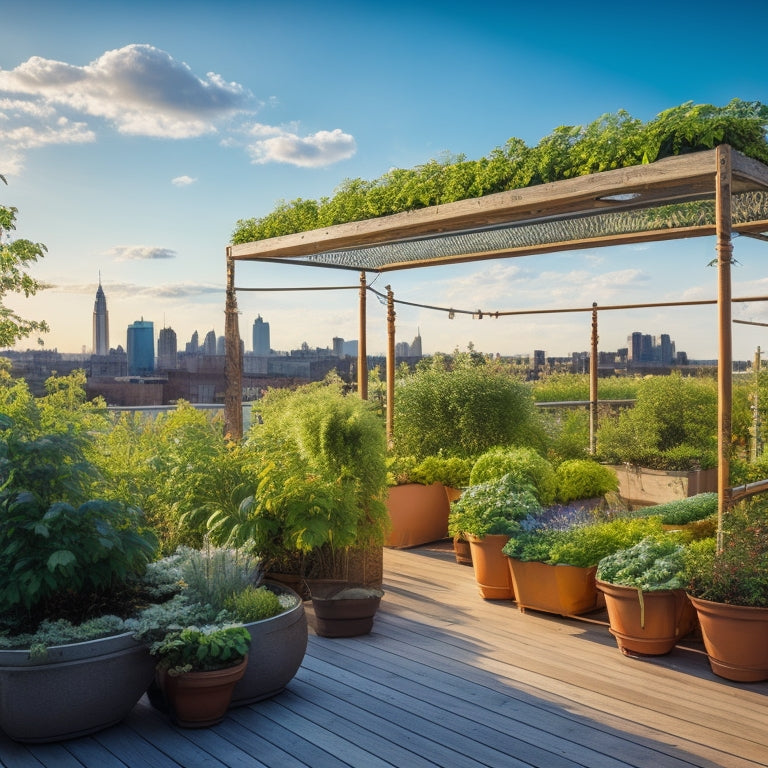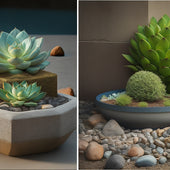
Rooftop Vegetable Garden Layout Ideas With Trellis
Share
You can increase your rooftop garden's productivity by incorporating trellis systems, which enable you to maximize vertical space and grow vining vegetables like peas, cucumbers, and tomatoes in a compact and visually appealing way. Train climbing plants up trellises to make the most of rooftop walls and fences, and utilize efficient watering techniques. Position beds for ideal sunlight exposure and consider orientation for different plant types. As you plan your layout, think about incorporating A-frame and corner trellis designs to optimize space and sunlight penetration. Now, get ready to elevate your rooftop garden's style and yield.
Key Takeaways
• Train vining vegetables to climb up trellis, maximizing rooftop space and promoting efficient growth.
• Choose sturdy trellis systems with adequate height and support for mature plant weight, ensuring healthy growth.
• Position rooftop garden beds for optimal sunlight exposure, considering orientation for different plant types and accessibility.
• Incorporate A-frame and corner trellis designs to utilize corner spaces efficiently and promote better air circulation and sunlight penetration.
• Balance aesthetics and functionality by combining symmetrical and asymmetrical elements, selecting colors that complement architecture, and incorporating textures and patterns.
Maximizing Space With Vertical Trellis
By training vining vegetables like peas, beans, and tomatoes to climb up a vertical trellis, you can take advantage of the often-wasted space on your rooftop garden's walls and fences. This clever technique allows you to grow more produce in a smaller area, making the best use of your rooftop's real estate.
To optimize growth, make sure to provide your climbing vegetables with a soil depth of at least 6-8 inches, allowing for adequate root development. Implement efficient watering techniques, such as drip irrigation or soaker hoses, to deliver water directly to the roots and minimize evaporation.
By incorporating companion planting, you can naturally deter pests and encourage healthy growth. For instance, planting marigolds alongside tomatoes can repel nematodes, while basil's fragrance can ward off aphids.
Trellis Systems for Climbing Vegetables
When selecting a trellis system for your climbing vegetables, choose a sturdy structure that can support the mature weight of your plants, such as a wooden or metal frame with a grid pattern or a teepee-style trellis with a wide base. A well-designed trellis not only provides climbing vegetable support but also adds visual appeal to your rooftop garden layout. Consider trellis aesthetics, blending functionality with style to create a harmonious garden atmosphere.
For a functional design, make sure your trellis is at least 6-8 feet tall to accommodate the mature height of your climbing vegetables. You can also use a trellis with adjustable arms or a rotating trellis to optimize space and facilitate pruning.
When integrating your trellis into your garden layout, consider the direction of sunlight and air circulation to promote healthy plant growth. By selecting the right trellis system, you'll create a thriving and beautiful rooftop vegetable garden that benefits both you and those you're serving.
Rooftop Garden Bed Orientation Tips
Your rooftop garden bed's orientation plays an important role in harnessing sunlight and airflow, so position it to receive ideal southern exposure, ideally between 15 and 40 degrees east or west of true south. This orientation allows your plants to receive the best amount of sunlight, promoting healthy growth and development.
When planning your bed orientation, contemplate the plant arrangement you want to achieve. For example, if you're growing vining plants like cucumbers or peas, opt for a north-south orientation to maximize space and sunlight penetration.
It's also essential to take into account the surrounding environment, including nearby buildings or structures that may cast shade or create wind tunnels. By positioning your bed correctly, you can minimize these effects and create a more favorable growing environment.
Additionally, ponder the accessibility of your bed when planning the orientation. Make sure it's easy to reach and maintain, especially if you have multiple beds or a large rooftop garden.
Incorporating A-Frame Trellis Designs
To maximize vertical space and add visual interest to your rooftop garden, consider incorporating A-frame trellis designs that support climbing plants like peas, beans, and tomatoes. This design element not only provides structural support but also adds a touch of elegance to your garden.
When selecting an A-frame trellis, prioritize sustainability by opting for materials that are eco-friendly and durable. For instance, consider using reclaimed wood or recycled metal to create a unique and environmentally conscious trellis design.
Some benefits of incorporating A-frame trellis designs into your rooftop garden include:
- Enhanced trellis aesthetics that add visual appeal to your garden
- Improved rooftop garden privacy by creating a natural screen
- Increased yield from climbing plants that utilize vertical space
Utilizing Corner Trellis Spaces
As you design your rooftop vegetable garden, you'll want to maximize every inch of space, especially in corners where trellises can be used to train vining plants upwards.
By cleverly utilizing these corner areas, you'll not only optimize your garden's layout but also create a visually appealing display.
Corner Space Optimization
Optimizing corner spaces with trellis systems reveals hidden potential in your rooftop vegetable garden. This allows you to cultivate a bounty of vining plants in areas often left underutilized. By incorporating corner planters and trellis design, you can reveal the full potential of your garden's vertical space.
Here are some innovative ways to optimize your corner spaces:
-
Use triangular trellises that fit snugly into corners, providing support for climbing plants like peas, beans, or cucumbers.
-
Install corner planters with built-in trellis systems, allowing you to grow vining plants like tomatoes or squash.
-
Create a corner focal point with a statement trellis piece, adding visual interest to your rooftop garden while supporting a variety of plants.
Vertical Plant Training
By leveraging the corner lattice spaces, you can train climbing plants to grow upwards, maximizing your rooftop garden's vertical real estate while adding a touch of sophistication to the overall design. This vertical plant training technique not only optimizes space but also provides better air circulation, sunlight penetration, and easier harvesting.
To ensure the success of your DIY lattice project, incorporate innovative plant support solutions, such as using twine or clips to secure the vines. Regular lattice maintenance tips include pruning and training the vines to grow in the desired direction.
By doing so, you'll reap the benefits of a vertical garden, including increased yield, reduced soil erosion, and improved aesthetics. As you design your rooftop garden, remember to take into account the mature size of your climbing plants and leave enough space for growth.
With careful planning and attention to detail, your corner lattice spaces will thrive, providing a bountiful harvest and a beautiful focal point for your rooftop oasis.
Compact Vining Solutions
You can reveal the full potential of your rooftop garden's corner trellis spaces by embracing compact vining solutions that make the most of every inch. By selecting vining plant varieties that thrive in tight spaces, you can create a lush and productive garden even in the most compact areas.
Here are some compact vining solutions to explore:
-
Train vining plants like peas, beans, or cucumbers to climb up a trellis, maximizing vertical space and keeping the area beneath clear for other plants.
-
Use a trellis with a narrow footprint to support vining plants like tomatoes or squash, keeping them upright and organized.
-
Incorporate a living wall or vertical garden into your trellis design, providing a space for vining plants to spread out while keeping the area in front clear.
Creating a Living Wall Trellis
Four to six feet of wall space is typically necessary to establish a thriving living wall trellis that can support a variety of vining vegetables and flowers.
With a DIY trellis installation, you can enjoy the green wall benefits of enhanced air quality, reduced urban heat island effect, and increased biodiversity.
As an urban gardener, incorporating sustainable design principles into your rooftop garden layout can have a significant impact on the environment.
When creating a living wall trellis, take into account the weight and growth habits of the plants you'll be supporting. Choose a sturdy trellis material, such as wood or metal, and make sure it's securely attached to the wall to prevent damage or collapse.
You'll also want to evaluate the irrigation and drainage needs of your plants, as well as access for pruning and maintenance.
Trellis Placement for Optimal Sunlight
When planning your rooftop vegetable garden, you'll want to strategically position your trellis to maximize sunlight exposure.
By placing your trellis in a south-facing direction, you'll capture the most direct sunlight, which is ideal for vining plants like peas, beans, and cucumbers.
However, be mindful of potential shading issues, as nearby structures or plants can cast unwanted shadows on your trellis.
South-Facing Trellis Placement
One of the most critical factors for a thriving rooftop vegetable garden is strategically placing trellises on south-oriented walls to capitalize on the maximum amount of direct sunlight. By doing so, you'll be able to provide your climbing plants with the energy they need to grow and thrive.
Here are some key benefits to keep in mind when positioning your trellis on a south-oriented wall:
-
Maximize sunlight exposure: South-oriented walls receive direct sunlight for the longest period, making them ideal for plants that require full sun.
-
Optimize trellis positioning: Place your trellis at an angle to make sure that the plants receive sunlight throughout the day, even during the winter months when the sun is lower in the sky.
-
Increase yield: By providing your plants with the right amount of sunlight, you can expect a higher yield and more bountiful harvests.
Shading Considerations
Shading Considerations
While strategically placing trellises on south-facing walls is crucial, you should also consider the potential for shading from surrounding structures or vegetation, which can greatly impact the amount of sunlight your climbing plants receive. Shading can be a significant obstacle to ideal plant growth, as it reduces sunlight exposure and can lead to weak and spindly stems.
To optimize your trellis is positioned for maximum sunlight, consider the following factors:
| Shading Source | Impact on Sunlight | Trellis Positioning Adjustment |
|---|---|---|
| Neighboring buildings | Partial shading, especially during peak hours | Position trellis to receive morning or afternoon sun |
| Trees or large shrubs | Dappled shading, varying throughout the day | Prune trees or shrubs to allow filtered sunlight to reach the trellis |
| Rooftop structures (e.g., vents, skylights) | Obstructed sunlight, potentially casting shadows | Position trellis to avoid shadows, or use reflective materials to bounce sunlight onto the plants |
| Other rooftop features (e.g., solar panels, HVAC units) | Partial shading, potentially blocking sunlight | Position trellis to receive indirect sunlight or use grow lights to supplement natural light |
Balancing Aesthetics With Functionality
By incorporating thoughtful design elements, you can craft a rooftop vegetable garden that seamlessly balances visual appeal with productive functionality. A well-designed garden not only provides a bounty of fresh produce but also becomes a tranquil oasis in the midst of a bustling city.
To achieve this balance, consider the following key elements:
-
Symmetry and Asymmetry: Combine symmetrical elements, like identical planters, with asymmetrical elements, like a meandering trellis, to create visual interest.
-
Color Palette: Select a palette that complements the surrounding architecture and incorporates a range of hues to add depth and visual appeal.
-
Texture and Pattern: Incorporate a variety of textures, such as smooth stone and rough wood, and patterns, like stripes and polka dots, to add depth and visual interest.
Frequently Asked Questions
Can I Use a Trellis With a Weighted Rooftop Garden?
As you envision a lush oasis, you wonder if a trellis can anchor your weighted rooftop haven. Yes, it can! Guarantee trellis stability by securing it to the rooftop structure, balancing weight distribution, and choosing a design that harmonizes with your garden's aesthetic.
How Do I Secure a Trellis in High-Wind Areas?
You'll need to secure your trellis in high-wind areas by choosing anchor options like heavy-duty screws or weighted bases, using wind-resistant materials, and following installation tips like anchoring to a solid structure, ensuring maintenance requirements are met.
Are Trellises Suitable for Rooftop Gardens With Limited Access?
'When designing for tricky rooftop spaces, you'll find trellises can thrive with meticulous planning. Opt for compact, lightweight designs, and pair with vertical gardening and container gardening techniques, clever watering methods, and strategic plant selection to guarantee success.'
Can I Use a Trellis With a Rooftop Garden on a Slanted Roof?
When designing a rooftop garden on a slanted roof, you'll want to evaluate vertical gardening with a trellis to maximize space. Make sure proper drainage solutions and opt for container gardening with carefully selected plants that thrive in sloping conditions.
Do I Need to Add Extra Support for Heavy Fruiting Vegetables?
When growing heavy fruiting vegetables, you'll need to determine if extra support is necessary or optional, considering the weight distribution on your rooftop garden, and whether your trellis can handle the added load.
Related Posts
-

What Makes a Great Planter for Succulents
When selecting a great planter for succulents, you'll want to take into account a combination of factors to guarantee...
-

What Makes a Great Planter for Succulents
When selecting a great planter for succulents, you'll want to take into account a combination of factors to guarantee...
-

What Makes a Great Planter for Succulents
When selecting a great planter for succulents, you'll want to take into account a combination of factors to guarantee...
-

What Makes a Great Planter for Succulents
When selecting a great planter for succulents, you'll want to take into account a combination of factors to guarantee...
-

What Makes a Great Planter for Succulents
When selecting a great planter for succulents, you'll want to take into account a combination of factors to guarantee...
-

What Makes a Great Planter for Succulents
When selecting a great planter for succulents, you'll want to take into account a combination of factors to guarantee...
-

What Makes a Great Planter for Succulents
When selecting a great planter for succulents, you'll want to take into account a combination of factors to guarantee...
-

What Makes a Great Planter for Succulents
When selecting a great planter for succulents, you'll want to take into account a combination of factors to guarantee...
-

What Makes a Great Planter for Succulents
When selecting a great planter for succulents, you'll want to take into account a combination of factors to guarantee...
-

What Makes a Great Planter for Succulents
When selecting a great planter for succulents, you'll want to take into account a combination of factors to guarantee...
-

What Makes a Great Planter for Succulents
When selecting a great planter for succulents, you'll want to take into account a combination of factors to guarantee...
-

What Makes a Great Planter for Succulents
When selecting a great planter for succulents, you'll want to take into account a combination of factors to guarantee...
-

What Makes a Great Planter for Succulents
When selecting a great planter for succulents, you'll want to take into account a combination of factors to guarantee...
-

What Makes a Great Planter for Succulents
When selecting a great planter for succulents, you'll want to take into account a combination of factors to guarantee...
-

What Makes a Great Planter for Succulents
When selecting a great planter for succulents, you'll want to take into account a combination of factors to guarantee...
-

What Makes a Great Planter for Succulents
When selecting a great planter for succulents, you'll want to take into account a combination of factors to guarantee...
-

What Makes a Great Planter for Succulents
When selecting a great planter for succulents, you'll want to take into account a combination of factors to guarantee...
-

What Makes a Great Planter for Succulents
When selecting a great planter for succulents, you'll want to take into account a combination of factors to guarantee...
-

What Makes a Great Planter for Succulents
When selecting a great planter for succulents, you'll want to take into account a combination of factors to guarantee...
-

What Makes a Great Planter for Succulents
When selecting a great planter for succulents, you'll want to take into account a combination of factors to guarantee...
-

What Makes a Great Planter for Succulents
When selecting a great planter for succulents, you'll want to take into account a combination of factors to guarantee...
-

What Makes a Great Planter for Succulents
When selecting a great planter for succulents, you'll want to take into account a combination of factors to guarantee...
-

What Makes a Great Planter for Succulents
When selecting a great planter for succulents, you'll want to take into account a combination of factors to guarantee...
-

What Makes a Great Planter for Succulents
When selecting a great planter for succulents, you'll want to take into account a combination of factors to guarantee...
-

5 Tips for Shaded Area Gardening Success
To turn your shaded areas into thriving gardens, start by selecting shade-tolerant crops like leafy greens and herbs,...
-

5 Tips for Shaded Area Gardening Success
To turn your shaded areas into thriving gardens, start by selecting shade-tolerant crops like leafy greens and herbs,...
-

5 Tips for Shaded Area Gardening Success
To turn your shaded areas into thriving gardens, start by selecting shade-tolerant crops like leafy greens and herbs,...
-

5 Tips for Shaded Area Gardening Success
To turn your shaded areas into thriving gardens, start by selecting shade-tolerant crops like leafy greens and herbs,...
-

5 Tips for Shaded Area Gardening Success
To turn your shaded areas into thriving gardens, start by selecting shade-tolerant crops like leafy greens and herbs,...
-

5 Tips for Shaded Area Gardening Success
To turn your shaded areas into thriving gardens, start by selecting shade-tolerant crops like leafy greens and herbs,...
-

5 Tips for Shaded Area Gardening Success
To turn your shaded areas into thriving gardens, start by selecting shade-tolerant crops like leafy greens and herbs,...
-

5 Tips for Shaded Area Gardening Success
To turn your shaded areas into thriving gardens, start by selecting shade-tolerant crops like leafy greens and herbs,...
-

5 Tips for Shaded Area Gardening Success
To turn your shaded areas into thriving gardens, start by selecting shade-tolerant crops like leafy greens and herbs,...
-

5 Tips for Shaded Area Gardening Success
To turn your shaded areas into thriving gardens, start by selecting shade-tolerant crops like leafy greens and herbs,...
-

5 Tips for Shaded Area Gardening Success
To turn your shaded areas into thriving gardens, start by selecting shade-tolerant crops like leafy greens and herbs,...
-

5 Tips for Shaded Area Gardening Success
To turn your shaded areas into thriving gardens, start by selecting shade-tolerant crops like leafy greens and herbs,...
-

5 Tips for Shaded Area Gardening Success
To turn your shaded areas into thriving gardens, start by selecting shade-tolerant crops like leafy greens and herbs,...
-

5 Tips for Shaded Area Gardening Success
To turn your shaded areas into thriving gardens, start by selecting shade-tolerant crops like leafy greens and herbs,...
-

5 Tips for Shaded Area Gardening Success
To turn your shaded areas into thriving gardens, start by selecting shade-tolerant crops like leafy greens and herbs,...
-

5 Tips for Shaded Area Gardening Success
To turn your shaded areas into thriving gardens, start by selecting shade-tolerant crops like leafy greens and herbs,...
-

5 Tips for Shaded Area Gardening Success
To turn your shaded areas into thriving gardens, start by selecting shade-tolerant crops like leafy greens and herbs,...
-

5 Tips for Shaded Area Gardening Success
To turn your shaded areas into thriving gardens, start by selecting shade-tolerant crops like leafy greens and herbs,...
-

5 Tips for Shaded Area Gardening Success
To turn your shaded areas into thriving gardens, start by selecting shade-tolerant crops like leafy greens and herbs,...
-

5 Tips for Shaded Area Gardening Success
To turn your shaded areas into thriving gardens, start by selecting shade-tolerant crops like leafy greens and herbs,...
-

Succulent-Friendly Drainage Solutions for Block Planters
You can create a succulent-friendly drainage system in your cinder block planters by drilling holes in the bottom of ...
-

Succulent-Friendly Drainage Solutions for Block Planters
You can create a succulent-friendly drainage system in your cinder block planters by drilling holes in the bottom of ...
-

Succulent-Friendly Drainage Solutions for Block Planters
You can create a succulent-friendly drainage system in your cinder block planters by drilling holes in the bottom of ...
-

Succulent-Friendly Drainage Solutions for Block Planters
You can create a succulent-friendly drainage system in your cinder block planters by drilling holes in the bottom of ...
-

Succulent-Friendly Drainage Solutions for Block Planters
You can create a succulent-friendly drainage system in your cinder block planters by drilling holes in the bottom of ...
-

Succulent-Friendly Drainage Solutions for Block Planters
You can create a succulent-friendly drainage system in your cinder block planters by drilling holes in the bottom of ...
-

Succulent-Friendly Drainage Solutions for Block Planters
You can create a succulent-friendly drainage system in your cinder block planters by drilling holes in the bottom of ...
-

Succulent-Friendly Drainage Solutions for Block Planters
You can create a succulent-friendly drainage system in your cinder block planters by drilling holes in the bottom of ...
-

Succulent-Friendly Drainage Solutions for Block Planters
You can create a succulent-friendly drainage system in your cinder block planters by drilling holes in the bottom of ...
-

Succulent-Friendly Drainage Solutions for Block Planters
You can create a succulent-friendly drainage system in your cinder block planters by drilling holes in the bottom of ...
-

Succulent-Friendly Drainage Solutions for Block Planters
You can create a succulent-friendly drainage system in your cinder block planters by drilling holes in the bottom of ...
-

Succulent-Friendly Drainage Solutions for Block Planters
You can create a succulent-friendly drainage system in your cinder block planters by drilling holes in the bottom of ...
-

Succulent-Friendly Drainage Solutions for Block Planters
You can create a succulent-friendly drainage system in your cinder block planters by drilling holes in the bottom of ...
-

Succulent-Friendly Drainage Solutions for Block Planters
You can create a succulent-friendly drainage system in your cinder block planters by drilling holes in the bottom of ...
-

Succulent-Friendly Drainage Solutions for Block Planters
You can create a succulent-friendly drainage system in your cinder block planters by drilling holes in the bottom of ...


